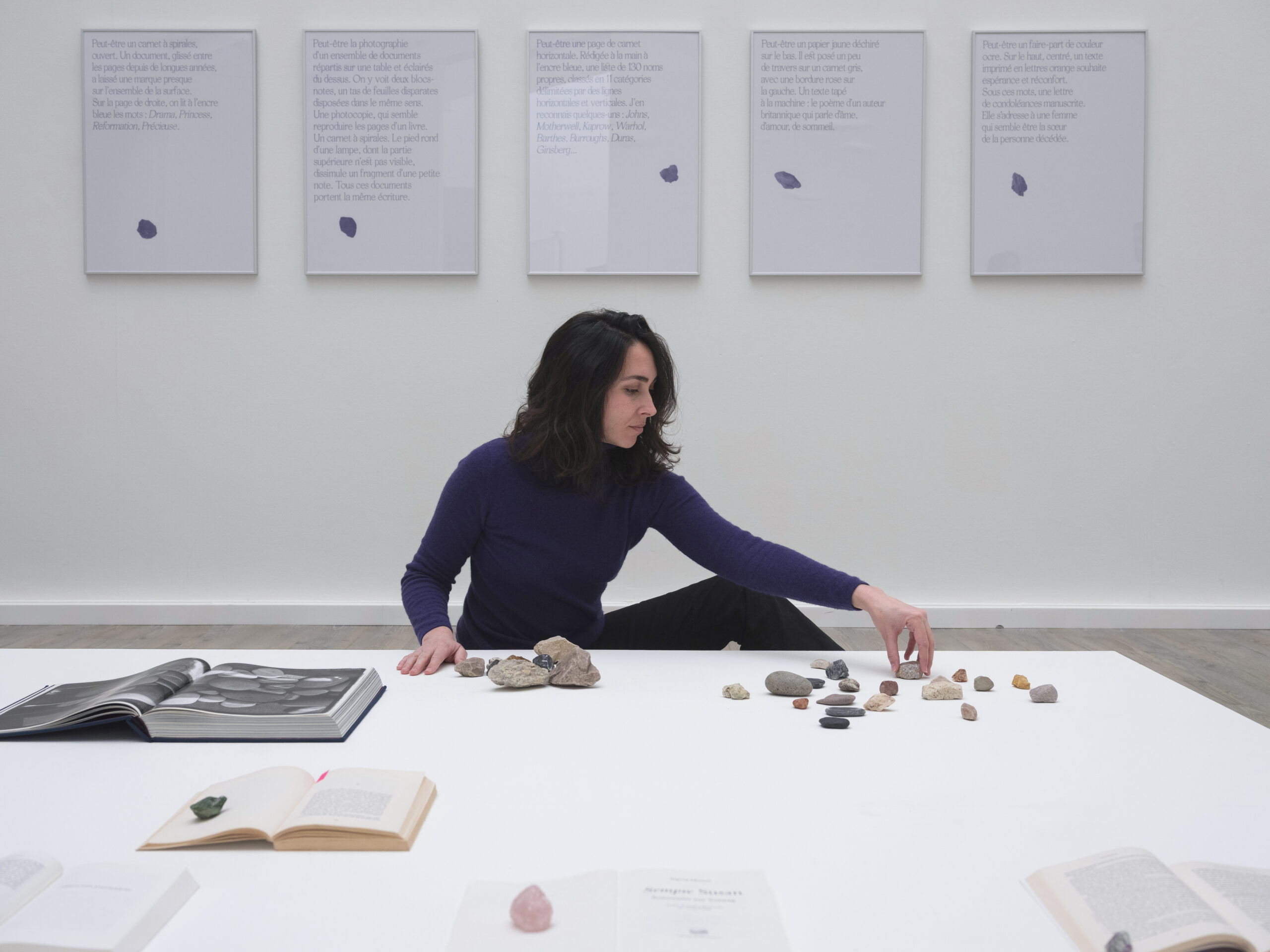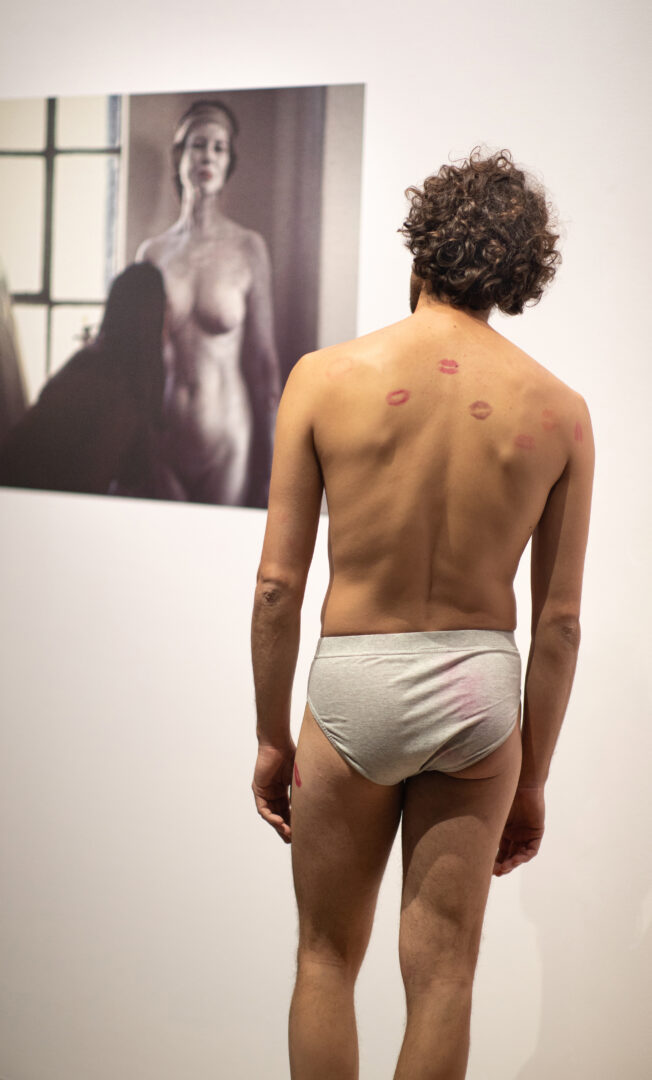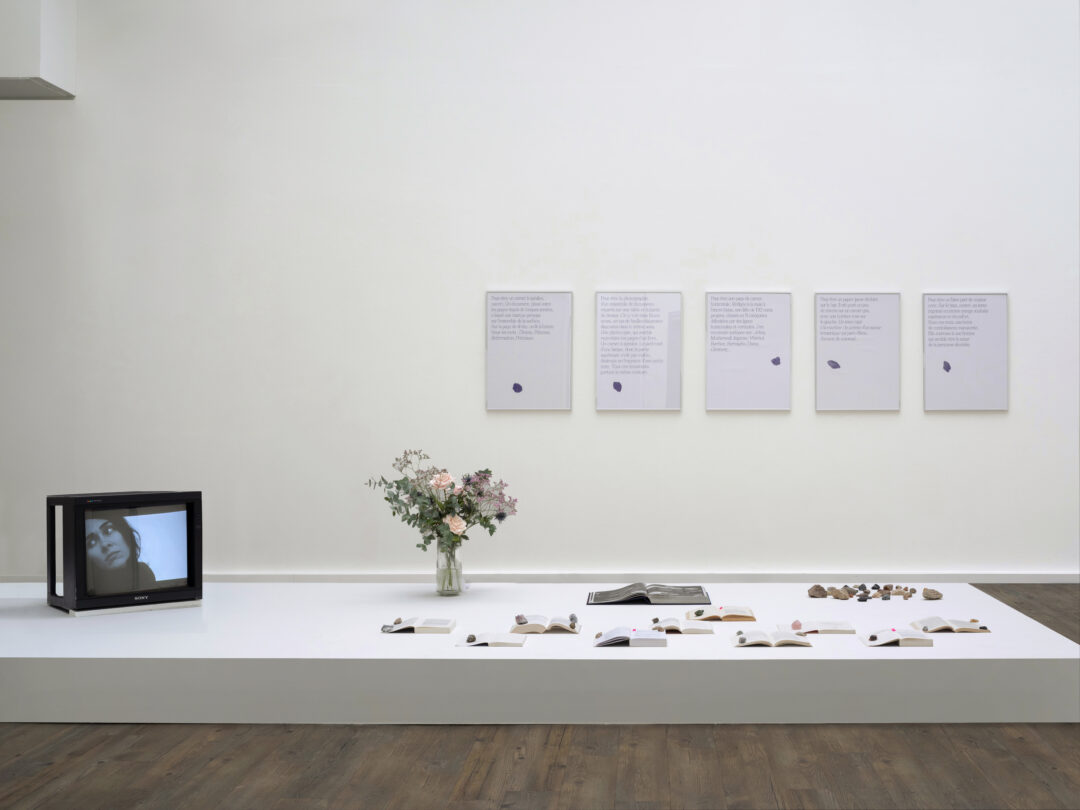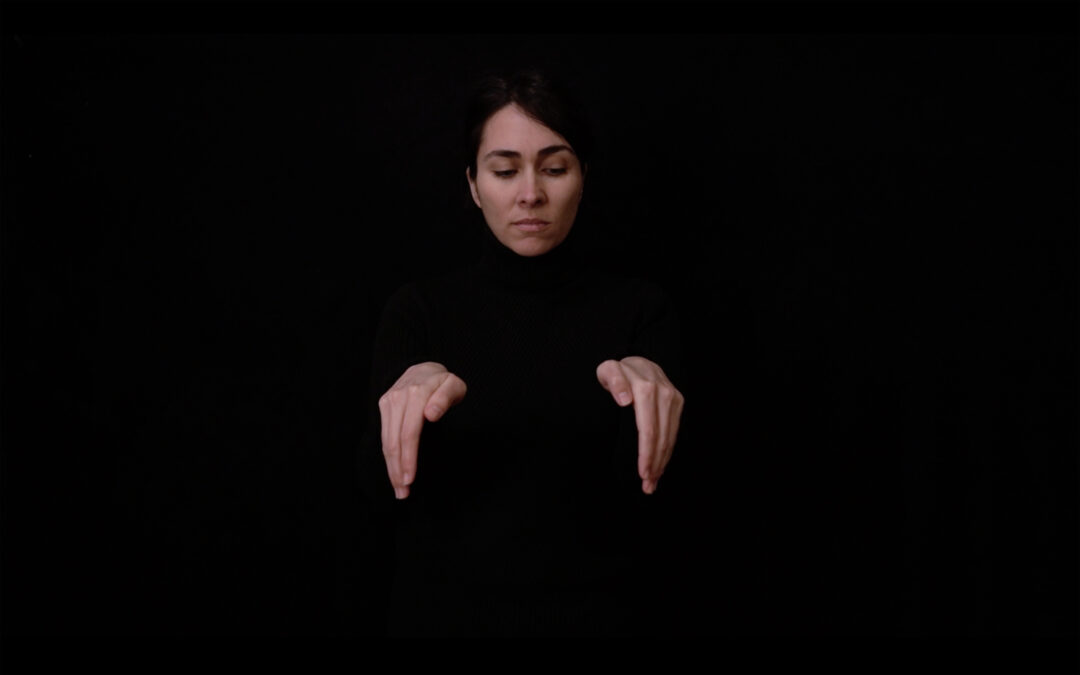Carole Douillard

Crown Shyness
From 17 January to 22 March, visitors to the National Theater in Le Mans (Scène nationale du Mans), discovered a new solo exhibition by Carole Douillard, “The Sontag Phenomenon” (Phénomène Sontag). The exhibition, which situates itself at the crossroads between the visual and performing arts and opens up numerous perspectives and powerful dynamics, was developed through the CURA program and partnerships with the CNAP (Centre national des arts plastiques) and the ASN (Association des Scènes nationales).
Carole Douillard (b. 1971, Nantes) makes use of her own presence as well as that of interpreters or performers to carry out minimalistic interventions and social sculptures. The resulting object of her work calls for the redefinition of art—often seen as a materiality which can be consumed—as the act of seeing or making something visible, instead. Carole Douillard’s practice balances on the edge of the spectacular; it questions the role of individual and collective bodies in both private and public spheres through established forms (performance, photography, installation, living sculpture).
The Exhibition as Site of Use
“The Sontag Phenomenon” is a project which takes place over an extended period of time, and began with a residency in California organized by the Institut Français (Through programs such as Bourse Sur Mesure, Bourse Mira, Aides à la création, DRAC, Région Pays de la Loire). Over the course of three residencies lasting several months each, Carole Douillard visited UCLA’s Special Library Collection (2024, Los Angeles), in order to explore the texts and archives of American essayist and public intellectual Susan Sontag from the inside. A major 20th century avant-garde figure (especially with regard to the women’s emancipation movement), Sontag focused her critical lens on topics such as art, gender, imperialism, and the list goes on. With “The Sontag Phenomenon”, the artist carries out in-depth research on Sontag’s writings. In particular, Douillard examines Sontag’s views on interpretation, as well as the space bodies occupy (physically as well as socially) in a given context. This first chapter rendering, developed with accomplished curator Raphaël Brunel, takes the form of a relational space which functions as an open stage. Six new pieces occupy the exhibition space—a former foyer become passageway in the building’s new layout, become gallery. This coincidence is a happy one as in this case passage is an apt term: from one stage to another, one body to another, one use to another.

Performance interprétée par / Performance by Laurent Cebe. Vue de l’exposition / Exhibition view « Sur tes Lèvres », Le Lieu Unique, 2024. Courtesy Carole Douillard & ADAGP, Barbara T. Smith. Photo : Christophe Guary.
A Social Heritage
In the centre of the exhibition space, a platform has been built for I Made White Gestures Among Solitudes (J’ai fait des gestes blancs parmi les solitudes) to take place; a performance by the dancer Séverine Lefèvre which will be presented on several occasions during the entirety of the exhibition. The performance is based on a repertory of gestures originating from photographs of Sontag taken by Annie Liebowitz, her last partner. These gestures, taken from portraits and reprised in real time, make up an archive produced by a loved one; one which ended with the death of Sontag. The dancer’s body as it lays on the ground becomes one with the stage’s horizontality, like a recumbent effigy. This physical sedimentation of gesture creates a kind of autobiography of a young body in movement, which then protects itself, only to become repeatedly ill and then die. The work raises the question of representation, through a slippage from the personal to the public. The stage is also a pedestal for the display of Sontag’s works, which have been annotated by the artist, alongside a collection of stones gathered during trips abroad (a tradition inherited from her mother’s side, who is from Kabyle descent, where stones are placed along gravesites, to indicate a memorial space, as a way to symbolize the boundary between the living and the dead), along with a pile of postcards bearing Sontag quotes, like an epitaph in front of a flower arrangement (the exhibition opening coincided with the author’s birthdate).
By presenting bodies in motion and written thought on the same level, Carole Douillard offers a solution to the question of the use of the pedestal in an exhibition which includes archival materials. Here, the never-ending theatre of representation (social media) is on equal footing with thought (books). The pedestal turns into a stage. A socolo, or literally “shoe” for the artwork, the pedestal becomes a foundation for another essential type of capital: social heritage. Given the current climate of the world-as-platform, with American imperialism and its human hierarchies as current a topic as it was in Sontag’s day, Carole Douillard makes space for all bodies to access a common heritage.
Dying Onstage
The performance or partition set to choreography which is played back on a monitor also becomes an isolated hand gesture. With A White Gesture, a photograph depicting a pair of hands, a transition is made from a body in movement (that of the dancer) to the still image. The artist is fond of these types of formal slippages, one leading to another like the memory of a gesture, reminiscent of the phantomatic practices of dancers or musicians. A body practices a learned movement even when motion has ceased. In a similar way, Sontag’s Papers, a series of seven digital prints displayed on two walls, frame the objects and gestures in the space. The series confronts the archival document with the authority of Google (each text opens with “maybe”, peut-être: the computer seemingly worried that it has misunderstood the search). Since bodies are indeed the topic at hand, Google makes the connection with transhumanism, which would be the final stage of the capitalistic process. This outcome can only occur, however on the basis of the degradation of physical beings, which reduces everything to the value of functionality.

Exiting Capital’s Gaze
The video For Interpretation reproduces drawings or sketches made by Sontag using isolated gestures, like small marginalia or observations made by the author herself in her notebooks. In “Against Interpretation”, (1966), the author opposes any and all personal appropriation of a work. She suggests replacing commentary on art with the production of art, in order to allow for feeling. With the relational artwork “Doodles”, the practice of drawing—which historically has been seen as an intermediary or procedural phase—becomes a phenomenon; it is both performed and performative, protocol and archive. Action replaces object, gesture replaces accumulation. The situation which produces itself (we are invited to co-draw, to take detours, to flip through) is more than a teleology: it is a thought shared amongst Sontag and every one of us. Carole Douillard’s practice considers art as a vector for resistance against the dehumanization of a world where everything becomes transactional: geographical territories, actions, populations. Paradoxically, the more affluent a society becomes, the more it lacks in time. The object of this exhibition could therefore be considered to be: a mourning of the loss of modernist and rigid thought, to enable us to move toward a “transformative experience…, the production of a discourse of self-truth,” as suggested by Michel Foucault.
Community Resources
The term “crown shyness” designates the capacity of trees to communicate with one another through the branches of their crowns, without ever touching. It is a type of natural support network, a form of vital politeness, through which each organism permits the others to establish themselves, before determining their own role. The etymological meaning of Cura, the program which supports the project, is a reminder of the attention or care involved in exhibitions. With “The Sontag Phenomenon”, Carole Doullard creates a space where objects provide an invitation to initiate agency, the construction of active, open and shared thought processes. This first edition of the exhibition provides a bodily alternative to the readymade thoughts of a post-democratic era. “The Sontag Phenomenon” as structural support, whose medium is the message, is also a reminder that art can never be confined to a static position.
Whilst society today conditions as well as deconditions us, Carole Douillard’s work provides us with access to another type of space (the aptly-named foyer) in which to overcome ourselves through communion with others. The exhibition becomes an agent of collective transformation, one which invites its visitors to create new worlds, to draw out other types of representation, to build a new social architecture.
Since their initial meeting in 2006, artist Carole Douillard and curator Agnès Violeau have established a mutually supportive, collaborative relationship which has allowed each of them to develop their respective long-term research subjects. Within this reciprocal framework, the duo cultivates a perspective which goes beyond the mutual interests which initially brought them together—(e.g. the exhibition as site of encounters, the deconstruction of the apparatus of the spectacle, phenomenology, etc.), as well as the curatorial projects they have created together: Fondation Pernod Ricard, 2010; Beursschouwburg, 2012; WIELS, 2013; Palais de Tokyo/CNAP, 2014; Musée des Beaux-arts de Nantes, 2022-2023—a dialog which has led to diverse outcomes including joint writing projects and regular publications.
Carole Douillard holds diplomas from the Academy of Fine Arts, Nantes, 1997 (Ecole des Beaux-arts de Nantes) and the University of Franche-Comté (Université de Franche-Comté). Recent exhibition venues include LACE (2024, Los Angeles, Mac Val (2024, Ivry/Seine), Frac Pays de la Loire (2021, Nantes), Biennale d’Oslo (2019), Biennale de Lyon (2017), Palais de Tokyo (2014, Paris), Institut français of Algiers and Oran (2012-2015, Algeria), Centro de Arte Dos de Mayo (2014, Madrid), Wiels (2013, Brussels) etc. Upcoming projects include the Festival des attentions (Mac Val), Sur tes lèvres at Frac Pays de la Loire and Lieu Unique (Nantes), and Dance First Think Later (Arta Sperto, Les Communs, Genève).

Head image : Carole Douillard, Reconstruire l’image, 2025. Exemplaire de A Photographer’s Life d’Annie Leibovitz et collection de pierres de l’artiste / Copy of A Photographer’s Life by Annie Leibovitz and collection of the artist’s stones. Performance interprétée par / Performance by Séverine Lefèvre. Vue de l’exposition / Exhibition view « Phénomène Sontag », Les Quinconces & L’Espal, Scène nationale du Mans. Courtesy Carole Douillard & ADAGP, 2025. Photo : Sylvain Duffard.
- Share: ,
- By the same author: Chantal Akerman,
Related articles
Lou Masduraud
by Vanessa Morisset
Bharti Kher
by Sarah Matia Pasqualetti
Walter Swennen
by Guillaume Lasserre